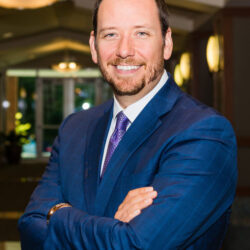Budgeting and saving: A pathway to happiness

People often think of budgeting and saving the same way they think about diet and exercise – a punishment. But one advisor wants people to regard budgeting and saving as a means to attaining what makes them happy – and he wants to teach others how to make that happen.

Tim Clairmont is founder the CEO of Clear Financial Partners, a wealth management firm in Lake Oswego, Ore. He is the best-selling author of two books, including What Should I Do With My 401(k)?
He told InsuranceNewsNet he wants his clients to learn as much about their money as possible so they can use it to “give themselves the biggest paychecks they can.”
And he visits local high schools to teach students how to calculate the real costs of borrowing money to buy a car or a house, among other things.
“I use my financial planning practice to teach clients what their options are,” he said. “We respect their right to choose what they want to do with their money. It's their money, so they get to choose what they want to do with it. We're transparent about all the pros and the cons, what we can control and what we can't control up front. So they never disappointed with a negative surprise. And then when they ask us for our help, we give them empathetic recommendations. Not everybody wants the same answer. It's not just computer software sense. It's what's right for them.”
Clairmont developed the ClearFP Clock App, in which users can learn financial principles they can implement to help them create their unique vision of happiness. He also launched a practice management program, the ClearFP Advisor Program, where he shares best practices with other advisors and shows advisors techniques for teaching clients about money.
The ClearFP Clock shows users how and when to tap into various income sources in retirement, Clairmont said.
“The first money that they touch is the income sources I can't do a lot about - things such as Social Security, pension plans, positive cash flow from rental properties, royalties, passive income from their business. All of that stuff is the first part of their retirement paycheck.
“The second money they touch is their income assets – that’s the proverbial goose that lays the golden eggs, and that’s the part I can help them with. There are various ways to invest the goose so you get bigger eggs. There are even ways to invest the goose in a way that if the goose dies, you still keep getting eggs – things like annuities or managed money strategies using bucket planning.”
Clairmont continues to use the analogy of the golden goose and its golden eggs to teach clients concepts such as the differences in rates of return.
“That's how fast the goose is growing or shrinking, or how big the goose egg is relative to the size of the goose,” he said.
But clients also must allocate money for something that’s fun, Clairmont added. That’s the third money on the clock. “That comes from liquid assets, and those liquid assets are for fun money as well as for emergency money,” he said. “That’s the guilty bucket as well as the guilt-free bucket of money.”
The final money the client can touch is what Clairmont called legacy money. “That’s the equity in your house or your real estate or your business as well as any kind of permanent life insurance benefit,” he said.
Clairmont also developed a Clear Income Plan to help clients figure out the answers to what he said are the two main questions preretirees ask:
- Where will my money come from in retirement?
- How much money will I get in retirement?
Budgeting and saving: Time is money
Clairmont has spoken to high school seniors about financial issues such as figuring out the real cost of borrowing money for a car or a house. He also teaches them how to figure out how much money they will have over a period of time – 30 years, for example – if they commit to saving $1,000 a month during that time at varying rates of return.
“I answer questions such as, how long will it take for you to save $1 million if you’re putting away $200 a month? Or, if you’re buying a car and the dealer tells you your monthly payment is X, how do you know how much the interest on that loan will be?
Clairmont often relates a story he told his son when his son was about to start his first day of kindergarten.
While the two of them were in the car before school started, Clairmont said, he showed his son the digital clock on the car’s dashboard and explained that every minute that passes on the clock is a minute you won’t get back. So those minutes must be used wisely.
“We have minutes of our life and we have dollars,” he said. “Both are limited resources. We financial advisors focus on getting the best return on investment for your dollars. But I want my clients to get the best ROI on their minutes. Our mission is empowering our clients in their journey to achieve their unique vision of happiness. I want to hear from them about what they’re doing that makes them happy.”
Susan Rupe is managing editor for InsuranceNewsNet. She formerly served as communications director for an insurance agents' association and was an award-winning newspaper reporter and editor. Contact her at Susan.Rupe@innfeedback.com. Follow her on Twitter @INNsusan.
© Entire contents copyright 2023 by InsuranceNewsNet.com Inc. All rights reserved. No part of this article may be reprinted without the expressed written consent from InsuranceNewsNet.com.





Empowering women through financial literacy
‘Annuity King’ calls Ponzi scheme charges ‘a joke;’ Trial starts today in Tampa
Advisor News
- Economist: Tariffs could dampen GDP growth; raise unemployment, inflation
- Medium tenure for workers remains at about 5 years
- Making the most of Financial Literacy Month
- Tariffs alter Q2 economic outlook downward, Morningstar says
- Women need an advisor who’s also a coach
More Advisor NewsAnnuity News
- In times of market volatility, FIAs make the difference
- Charitable gift annuities gaining in popularity
- Nationwide and Annexus establish first actively managed mutual fund within a RILA
- AM Best Comments on the Credit Ratings of Talcott Financial Group Ltd.’s Subsidiaries Following Announced Reinsurance Transaction With Japan Post Insurance Co., Ltd.
- Globe Life Inc. (NYSE: GL) is a Stock Spotlight on 4/1
More Annuity NewsHealth/Employee Benefits News
- Health care costs bill signed by Lujan Grisham
- Friday roundtable in Rochester to focus on possible Medicaid cuts
- Studies from University of Southern California (USC) Yield New Information about Military Medicine (Health Insurance Coverage and Hearing Aid Utilization In Us Older Adults: National Health Interview Survey): Military Medicine
- Pritzker's Proposed Budget Will Take Away Health Coverage From Immigrants Without Legal Status
- A fifth of Americans are on Medicaid. Some of them have no idea.
More Health/Employee Benefits NewsLife Insurance News
- Proxy Statement (Form DEF 14A)
- Symetra Partners with Nayya to Introduce Digital Leaving Planning Solution
- Krispy Kreme's owner is seeking approval to buy Shenandoah Life
- Krispy Kreme owner to acquire Roanoke-based Shenandoah Life
- Directors' Report and Financial Statements 31 December 2024
More Life Insurance News